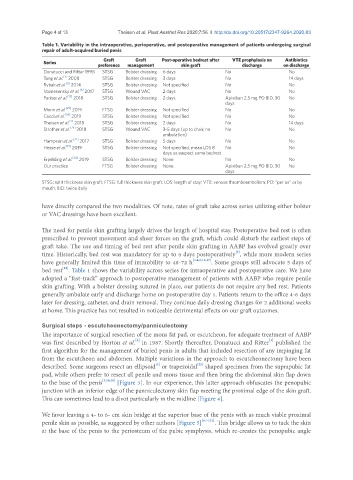Page 648 - Read Online
P. 648
Page 4 of 13 Theisen et al. Plast Aesthet Res 2020;7:56 I http://dx.doi.org/10.20517/2347-9264.2020.83
Table 1. Variability in the intraoperative, perioperative, and postoperative management of patients undergoing surgical
repair of adult-acquired buried penis
Series Graft Graft Post-operative bedrest after VTE prophylaxis on Antibiotics
preference management skin graft discharge on discharge
Donatucci and Ritter 1998 STSG Bolster dressing 6 days No No
[3]
Tang et al. 2008 STSG Bolster dressing 3 days No 14 days
[5]
Rybak et al. 2014 STSG Bolster dressing Not specified No No
[6]
Voznesensky et al. 2017 STSG Wound VAC 2 days No No
Pariser et al. [13] 2018 STSG Bolster dressing 2 days Apixiban 2.5 mg PO BID, 30 No
days
Monn et al. [23] 2019 FTSG Bolster dressing Not specified No No
Cocci et al. [39] 2019 STSG Bolster dressing Not specified No No
[7]
Theisen et al. 2018 STSG Bolster dressing 2 days No 14 days
Strother et al. [26] 2018 STSG Wound VAC 3-5 days (up to chair, no No No
ambulation)
Hampson et al. [22] 2017 STSG Bolster dressing 5 days No No
Hesse et al. [15] 2019 STSG Bolster dressing Not specified, mean LOS 8 No No
days so suspect some bedrest
Erpelding et al. [34] 2019 STSG Bolster dressing None No No
Our practice FTSG Bolster dressing None Apixiban 2.5 mg PO BID, 30 No
days
STSG: split thickness skin graft; FTSG: full thickness skin graft; LOS: length of stay; VTE: venous thromboembolism; PO: “per os” or by
mouth; BID: twice daily
have directly compared the two modalities. Of note, rates of graft take across series utilizing either bolster
or VAC dressings have been excellent.
The need for penile skin grafting largely drives the length of hospital stay. Postoperative bed rest is often
prescribed to prevent movement and sheer forces on the graft, which could disturb the earliest steps of
graft take. The use and timing of bed rest after penile skin grafting in AABP has evolved greatly over
[2]
time. Historically, bed rest was mandatory for up to 6 days postoperatively , while more modern series
have generally limited this time of immobility to 48-72 h [3,4,6,16,17] . Some groups still advocate 5 days of
bed rest . Table 1 shows the variability across series for intraoperative and postoperative care. We have
[22]
adopted a “fast-track” approach to postoperative management of patients with AABP who require penile
skin grafting. With a bolster dressing sutured in place, our patients do not require any bed rest. Patients
generally ambulate early and discharge home on postoperative day 1. Patients return to the office 4-6 days
later for dressing, catheter, and drain removal. They continue daily dressing changes for 2 additional weeks
at home. This practice has not resulted in noticeable detrimental effects on our graft outcomes.
Surgical steps - escutcheonectomy/panniculectomy
The importance of surgical resection of the mons fat pad, or escutcheon, for adequate treatment of AABP
[2]
[9]
was first described by Horton et al. in 1987. Shortly thereafter, Donatucci and Ritter published the
first algorithm for the management of buried penis in adults that included resection of any impinging fat
from the escutcheon and abdomen. Multiple variations in the approach to escutcheonectomy have been
[5]
[22]
described. Some surgeons resect an ellipsoid or trapezoidal shaped specimen from the suprapubic fat
pad, while others prefer to resect all penile and mons tissue and then bring the abdominal skin flap down
to the base of the penis [3,16,26] [Figure 3]. In our experience, this latter approach obfuscates the penopubic
junction with an inferior edge of the panniculectomy skin flap meeting the proximal edge of the skin graft.
This can sometimes lead to a divot particularly in the midline [Figure 4].
We favor leaving a 4- to 6- cm skin bridge at the superior base of the penis with as much viable proximal
penile skin as possible, as suggested by other authors [Figure 5] [6,14,22] . This bridge allows us to tack the skin
at the base of the penis to the periosteum of the pubic symphysis, which re-creates the penopubic angle

